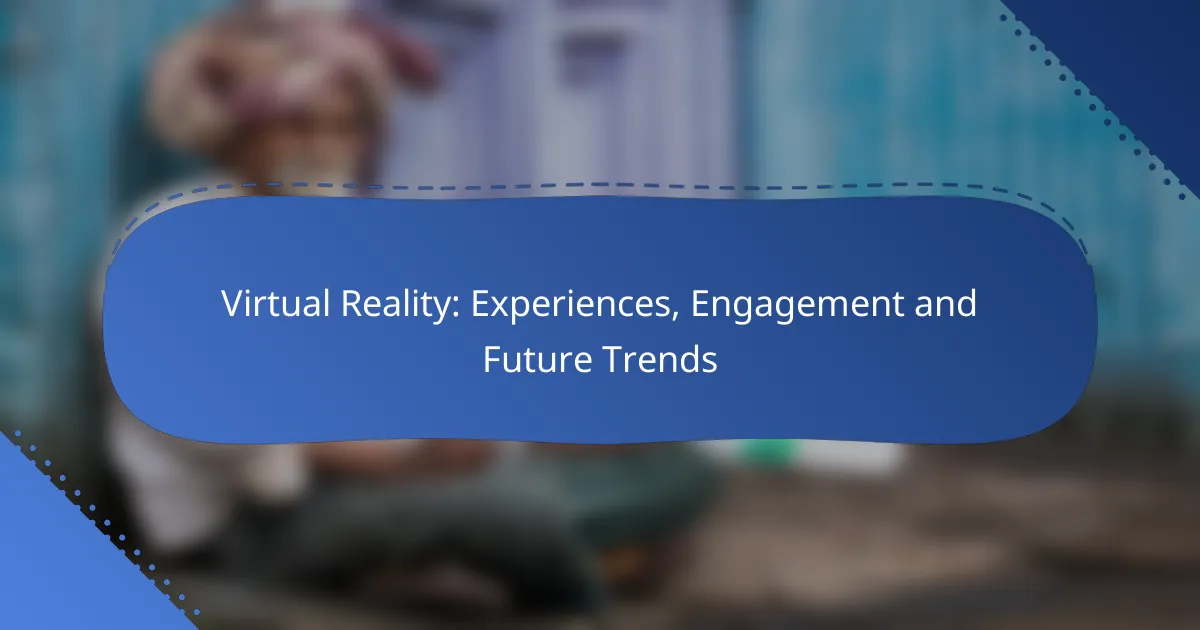Virtual Reality (VR) is revolutionizing the way we engage with digital content by offering immersive experiences that captivate users and foster active participation. From gaming and virtual travel to educational applications, VR creates emotional connections and enhances retention rates, making it a powerful tool for various industries. As brands increasingly adopt VR for marketing, they are able to craft unique storytelling experiences that leave lasting impressions on consumers.
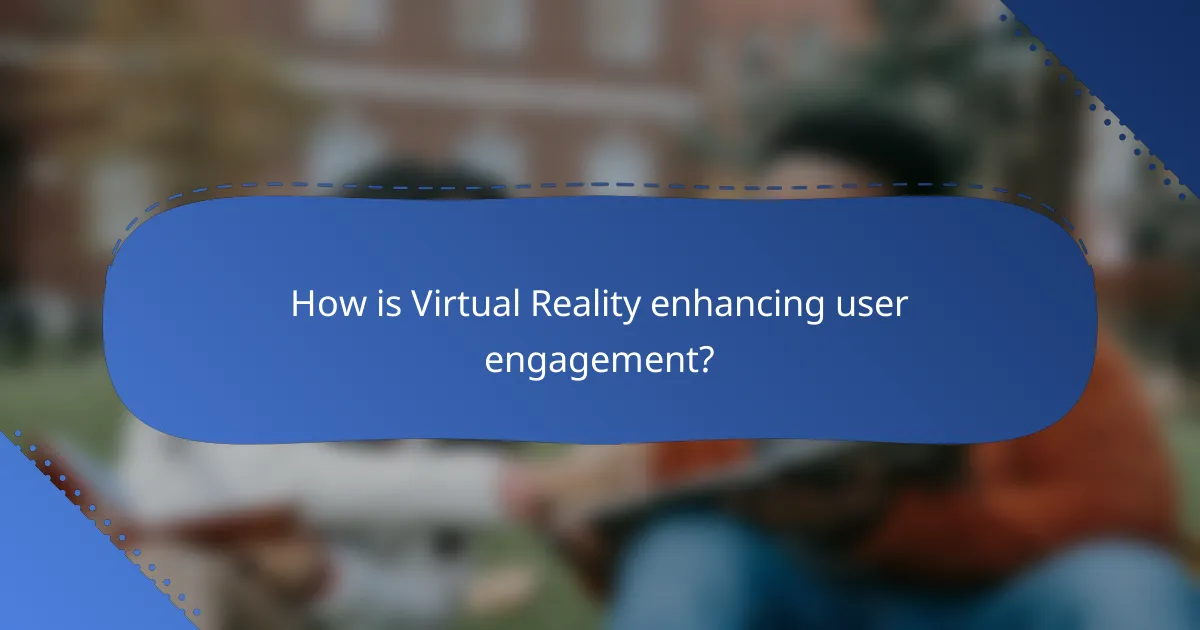
How is Virtual Reality enhancing user engagement?
Virtual Reality (VR) significantly enhances user engagement by creating immersive environments that captivate users’ attention and encourage active participation. By simulating real-world experiences, VR fosters deeper emotional connections and increases retention rates across various applications.
Immersive gaming experiences
VR has transformed gaming by providing players with fully immersive environments that enhance the overall experience. Players can interact with the game world in a more natural way, using their body movements and gestures, which leads to higher levels of engagement and enjoyment.
Popular VR games like “Beat Saber” and “Half-Life: Alyx” exemplify this trend, offering dynamic gameplay that feels more lifelike. Developers should focus on creating intuitive controls and rich narratives to maximize user immersion and satisfaction.
Virtual events and conferences
Virtual events and conferences leverage VR to create engaging, interactive experiences that replicate in-person gatherings. Attendees can navigate virtual spaces, network with others, and participate in live discussions, all from the comfort of their homes.
Platforms like Spatial and vFairs enable organizations to host events that can accommodate hundreds or thousands of participants, making it essential to consider user interface design and accessibility features to enhance engagement. Offering interactive elements, such as Q&A sessions and breakout rooms, can further enrich the experience.
Interactive training simulations
VR is increasingly used in training simulations across various industries, providing a safe environment for learners to practice skills without real-world consequences. This hands-on approach allows users to engage with the material actively, leading to better retention and understanding.
For instance, medical professionals can use VR to simulate surgeries, while corporate employees can practice customer service scenarios. Organizations should ensure that simulations are realistic and relevant to the tasks at hand, as this alignment is crucial for effective learning outcomes.
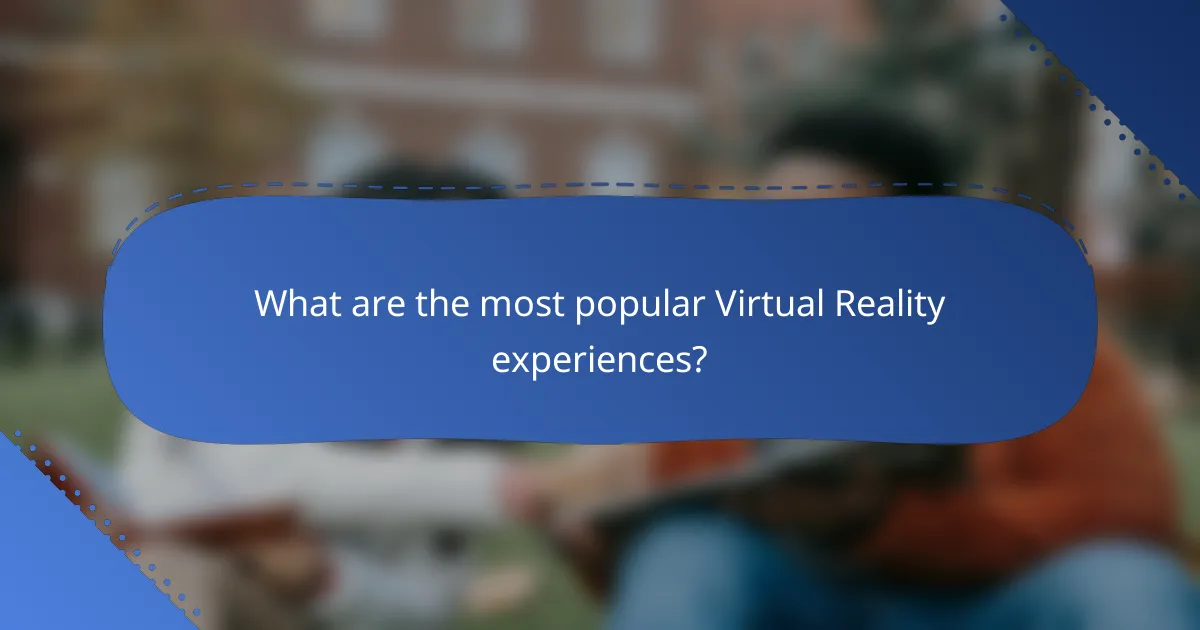
What are the most popular Virtual Reality experiences?
The most popular virtual reality experiences encompass a variety of engaging activities, including gaming, virtual travel, and educational applications. These experiences leverage immersive technology to transport users to new environments, enhance learning, and provide interactive entertainment.
VR gaming platforms like Oculus Quest
VR gaming platforms such as Oculus Quest have gained immense popularity due to their accessibility and immersive gameplay. These standalone devices do not require external sensors or a powerful PC, making them user-friendly for both beginners and seasoned gamers.
Popular titles on these platforms include action-packed games like “Beat Saber” and adventure experiences like “The Walking Dead: Saints & Sinners.” Users can enjoy a range of genres, from puzzle-solving to multiplayer experiences, enhancing social interaction in gaming.
Virtual travel experiences
Virtual travel experiences allow users to explore global destinations without leaving their homes. These experiences often include guided tours of historical sites, natural wonders, and cultural landmarks, providing a sense of presence in various locations.
Platforms like Wander and Oculus Venues offer users the chance to visit places like the Great Wall of China or the Louvre Museum. These experiences can be particularly valuable for those unable to travel due to financial constraints or mobility issues.
Educational VR applications
Educational VR applications are transforming the learning landscape by providing immersive environments for students. Subjects like history, science, and art can be taught through interactive simulations that engage learners in a unique way.
For instance, platforms such as Engage and ClassVR enable teachers to create virtual classrooms where students can participate in interactive lessons. This method enhances retention and understanding by allowing learners to visualize complex concepts in a three-dimensional space.
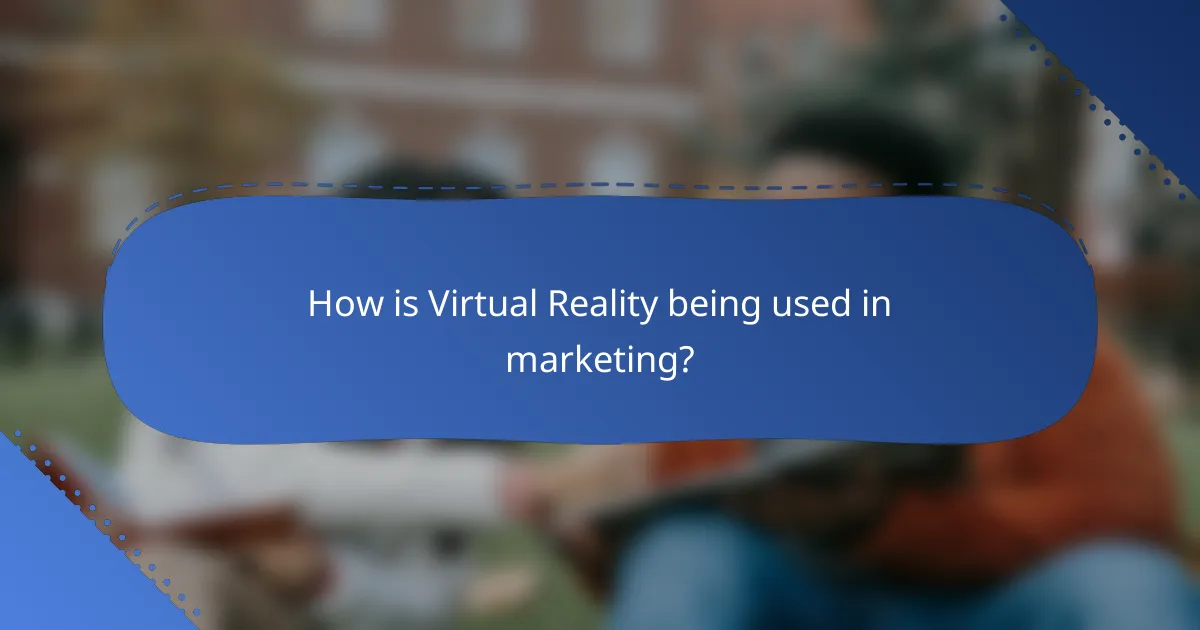
How is Virtual Reality being used in marketing?
Virtual Reality (VR) is transforming marketing by creating immersive experiences that engage consumers in unique ways. Brands leverage VR to enhance storytelling, showcase products, and create memorable interactions at events.
Brand storytelling through immersive ads
Immersive ads allow brands to tell their stories in a captivating manner, drawing consumers into a narrative. By using VR, companies can create environments where users experience the brand’s message firsthand, making it more impactful.
For instance, a travel company might use VR to transport users to a tropical destination, showcasing the sights and sounds, which can evoke emotions and drive bookings. This approach often leads to higher retention of the brand message compared to traditional advertising.
Virtual showrooms for product demos
Virtual showrooms provide an interactive platform for consumers to explore products in a 3D space. This allows potential buyers to examine items from various angles and even customize features, enhancing their understanding of the product.
For example, furniture retailers can create virtual spaces where customers visualize how a piece fits into their home. This method can significantly reduce return rates, as customers have a clearer expectation of what they are purchasing.
Engagement through VR experiences at events
VR experiences at events engage attendees by offering unique, interactive activities that stand out. Brands can create simulations or games that not only entertain but also educate participants about their products or services.
For instance, automotive companies might set up VR driving experiences at trade shows, allowing users to virtually test drive a car. This hands-on engagement can lead to increased interest and higher conversion rates post-event.

What are the key trends in Virtual Reality technology?
Key trends in Virtual Reality (VR) technology include advancements in hardware and software, integration with augmented reality (AR), and increased accessibility and affordability. These trends are shaping how users engage with VR, making experiences more immersive and widely available.
Advancements in hardware and software
Recent advancements in VR hardware and software have significantly enhanced user experiences. High-resolution displays, improved motion tracking, and more powerful processors allow for smoother and more realistic simulations. For example, headsets now often feature refresh rates exceeding 90 Hz, reducing motion sickness and improving immersion.
Software developments, including more sophisticated VR platforms and applications, enable diverse use cases from gaming to training simulations. Developers are increasingly utilizing game engines like Unity and Unreal Engine to create rich, interactive environments that engage users in new ways.
Integration with augmented reality
The integration of VR with augmented reality (AR) is a notable trend that expands the potential of both technologies. This hybrid approach allows users to interact with digital elements overlaid on the real world, enhancing experiences in fields such as education, healthcare, and entertainment. For instance, training programs can simulate real-world scenarios while providing contextual information through AR.
Companies are exploring mixed reality devices that combine VR and AR capabilities, like Microsoft’s HoloLens. These devices enable users to switch between fully immersive VR and AR experiences, broadening the scope of applications and user engagement.
Increased accessibility and affordability
As VR technology evolves, it is becoming more accessible and affordable for a wider audience. The introduction of standalone headsets, which do not require a powerful PC, has lowered the entry barrier for consumers. Devices like the Meta Quest 2 offer a complete VR experience at a fraction of the cost of traditional setups, often under $400.
Moreover, the growing availability of free or low-cost VR content, including educational resources and games, encourages more users to explore VR. This trend is likely to continue as more developers create content tailored for budget-friendly platforms, fostering a larger community of VR enthusiasts.
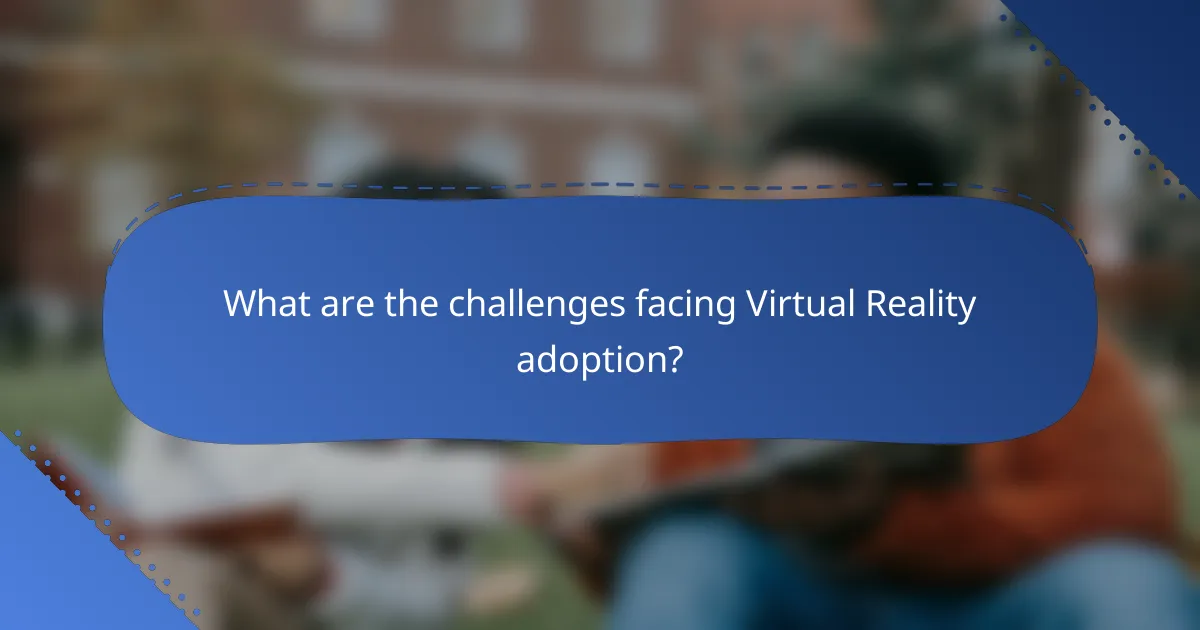
What are the challenges facing Virtual Reality adoption?
The challenges facing Virtual Reality (VR) adoption include high costs of equipment, limitations in content creation, and issues related to user comfort and motion sickness. These factors can hinder widespread acceptance and use of VR technology across various sectors.
High costs of equipment
The high costs associated with VR equipment are a significant barrier to adoption. Quality headsets and necessary hardware can range from several hundred to over a thousand USD, making it less accessible for casual users and smaller businesses.
Additionally, ongoing costs for upgrades and maintenance can add to the financial burden. Organizations considering VR solutions must weigh these expenses against potential benefits to determine feasibility.
Content creation limitations
Creating engaging VR content can be complex and resource-intensive, limiting the availability of high-quality experiences. Developers often face challenges in producing immersive environments that effectively utilize VR’s capabilities, which can result in a lack of diverse content.
Moreover, the skill set required for VR content creation is specialized, leading to a smaller pool of qualified developers. This can slow down the growth of the VR ecosystem as demand for innovative experiences continues to rise.
User comfort and motion sickness issues
User comfort is a critical concern in VR, as many individuals experience motion sickness or discomfort during use. This can occur due to latency issues, poor frame rates, or mismatched sensory inputs, which can deter users from engaging with VR technology.
To mitigate these issues, developers should prioritize optimizing performance and designing user-friendly interfaces. Providing options for shorter sessions and gradual acclimatization can also help users adapt more comfortably to VR experiences.
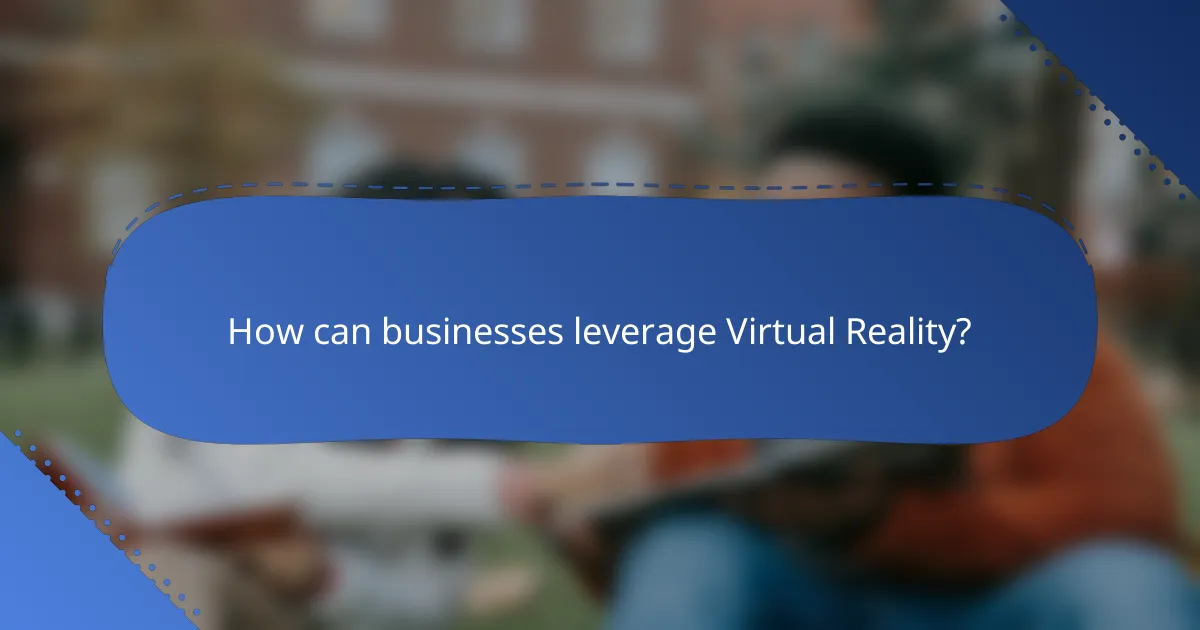
How can businesses leverage Virtual Reality?
Businesses can leverage Virtual Reality (VR) to enhance customer engagement, improve employee training, and facilitate remote collaboration. By integrating VR into their operations, companies can create immersive experiences that drive interaction and productivity.
Creating tailored customer experiences
VR allows businesses to craft personalized customer experiences that resonate with individual preferences. For instance, retailers can offer virtual showrooms where customers can explore products in a lifelike environment, leading to increased satisfaction and higher conversion rates.
To implement tailored experiences, companies should gather data on customer behavior and preferences. This information can then be used to design VR environments that cater specifically to target demographics, enhancing overall engagement.
Enhancing employee training programs
Virtual Reality can significantly improve employee training by providing realistic simulations that enhance learning outcomes. Industries such as healthcare and manufacturing benefit from VR training modules that allow employees to practice skills in a safe, controlled setting.
When developing VR training programs, businesses should focus on creating scenarios that reflect real-world challenges. Incorporating feedback mechanisms can also help trainees understand their performance and areas for improvement, leading to more effective skill acquisition.
Utilizing VR for remote collaboration
VR technology facilitates remote collaboration by creating virtual meeting spaces where teams can interact as if they were in the same room. This can enhance communication and teamwork, especially for organizations with distributed workforces.
To maximize the effectiveness of VR for remote collaboration, companies should invest in user-friendly platforms that support various devices. Regularly scheduled virtual meetings can help maintain team cohesion and ensure that all members are aligned on project goals.
